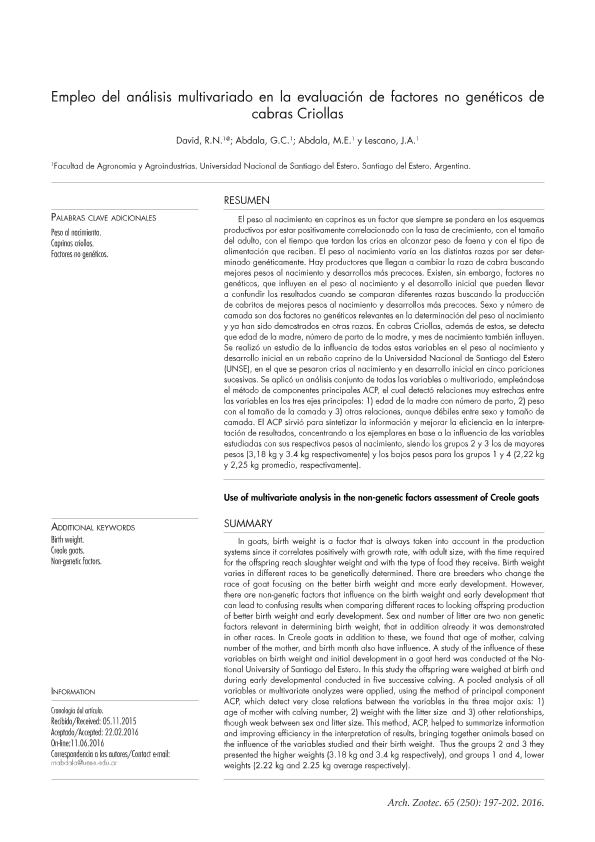Mostrar el registro sencillo del ítem
dc.contributor.author
David, R. N.
dc.contributor.author
Abdala, G. C.
dc.contributor.author
Abdala, María Eugenia

dc.contributor.author
Lescano, J. A.
dc.date.available
2018-05-29T22:19:41Z
dc.date.issued
2016-06
dc.identifier.citation
David, R. N.; Abdala, G. C.; Abdala, María Eugenia; Lescano, J. A.; Empleo del análisis multivariado en la evaluación de factores no genéticos de cabras Criollas
; UCOPRESS; Archivos de Zootecnia; 60; 250; 6-2016; 197-202
dc.identifier.issn
0004-0592
dc.identifier.uri
http://hdl.handle.net/11336/46554
dc.description.abstract
El peso al nacimiento en caprinos es un factor que siempre se pondera en los esquemas productivos por estar positivamente correlacionado con la tasa de crecimiento, con el tamaño del adulto, con el tiempo que tardan las crías en alcanzar peso de faena y con el tipo de alimentación que reciben. El peso al nacimiento varía en las distintas razas por ser determinado genéticamente. Hay productores que llegan a cambiar la raza de cabra buscando mejores pesos al nacimiento y desarrollos más precoces. Existen, sin embargo, factores no genéticos, que influyen en el peso al nacimiento y el desarrollo inicial que pueden llevar a confundir los resultados cuando se comparan diferentes razas buscando la producción de cabritos de mejores pesos al nacimiento y desarrollos más precoces. Sexo y número de camada son dos factores no genéticos relevantes en la determinación del peso al nacimiento y ya han sido demostrados en otras razas. En cabras Criollas, además de estos, se detecta que edad de la madre, número de parto de la madre, y mes de nacimiento también influyen. Se realizó un estudio de la influencia de todas estas variables en el peso al nacimiento y desarrollo inicial en un rebaño caprino de la Universidad Nacional de Santiago del Estero (UNSE), en el que se pesaron crías al nacimiento y en desarrollo inicial en cinco pariciones sucesivas. Se aplicó un análisis conjunto de todas las variables o multivariado, empleándose el método de componentes principales ACP, el cual detectó relaciones muy estrechas entre las variables en los tres ejes principales: 1) edad de la madre con número de parto, 2) peso con el tamaño de la camada y 3) otras relaciones, aunque débiles entre sexo y tamaño de camada. El ACP sirvió para sintetizar la información y mejorar la eficiencia en la interpretación de resultados, concentrando a los ejemplares en base a la influencia de las variables estudiadas con sus respectivos pesos al nacimiento, siendo los grupos 2 y 3 los de mayores pesos (3,18 kg y 3.4 kg respectivamente) y los bajos pesos para los grupos 1 y 4 (2,22 kg y 2,25 kg promedio, respectivamente).
dc.description.abstract
In goats, birth weight is a factor that is always taken into account in the production systems since it correlates positively with growth rate, with adult size, with the time required for the offspring reach slaughter weight and with the type of food they receive. Birth weight varies in different races to be genetically determined. There are breeders who change the race of goat focusing on the better birth weight and more early development. However, there are non-genetic factors that influence on the birth weight and early development that can lead to confusing results when comparing different races to looking offspring production of better birth weight and early development. Sex and number of litter are two non genetic factors relevant in determining birth weight, that in addition already it was demonstrated in other races. In Creole goats in addition to these, we found that age of mother, calving number of the mother, and birth month also have influence. A study of the influence of these variables on birth weight and initial development in a goat herd was conducted at the Na-tional University of Santiago del Estero. In this study the offspring were weighed at birth and during early developmental conducted in five successive calving. A pooled analysis of all variables or multivariate analyzes were applied, using the method of principal component ACP, which detect very close relations between the variables in the three major axis: 1) age of mother with calving number, 2) weight with the litter size and 3) other relationships, though weak between sex and litter size. This method, ACP, helped to summarize information and improving efficiency in the interpretation of results, bringing together animals based on the influence of the variables studied and their birth weight. Thus the groups 2 and 3 they presented the higher weights (3.18 kg and 3.4 kg respectively), and groups 1 and 4, lower weights (2.22 kg and 2.25 kg average respectively).
dc.format
application/pdf
dc.language.iso
spa
dc.publisher
UCOPRESS
dc.rights
info:eu-repo/semantics/openAccess
dc.rights.uri
https://creativecommons.org/licenses/by-nc-sa/2.5/ar/
dc.subject
Cabras Criollas
dc.subject
Analisis Multivariado
dc.subject
Parámetros No Genéticos
dc.subject.classification
Otras Producción Animal y Lechería

dc.subject.classification
Producción Animal y Lechería

dc.subject.classification
CIENCIAS AGRÍCOLAS

dc.title
Empleo del análisis multivariado en la evaluación de factores no genéticos de cabras Criollas
dc.title
Use of multivariate analysis in the non-genetic factors assessment of Creole goats
dc.type
info:eu-repo/semantics/article
dc.type
info:ar-repo/semantics/artículo
dc.type
info:eu-repo/semantics/publishedVersion
dc.date.updated
2018-05-28T14:51:58Z
dc.identifier.eissn
1885-4494
dc.journal.volume
60
dc.journal.number
250
dc.journal.pagination
197-202
dc.journal.pais
Argentina

dc.journal.ciudad
Cordoba
dc.description.fil
Fil: David, R. N.. Universidad Nacional de Santiago del Estero. Facultad de Agronomía y Agroindustrias; Argentina
dc.description.fil
Fil: Abdala, G. C.. Universidad Nacional de Santiago del Estero. Facultad de Agronomía y Agroindustrias; Argentina
dc.description.fil
Fil: Abdala, María Eugenia. Universidad Nacional de Santiago del Estero. Facultad de Agronomía y Agroindustrias; Argentina. Consejo Nacional de Investigaciones Científicas y Técnicas; Argentina
dc.description.fil
Fil: Lescano, J. A.. Universidad Nacional de Santiago del Estero. Facultad de Agronomía y Agroindustrias; Argentina
dc.journal.title
Archivos de Zootecnia

dc.relation.alternativeid
info:eu-repo/semantics/altIdentifier/url/http://www.redalyc.org/articulo.oa?id=49545852013
dc.relation.alternativeid
info:eu-repo/semantics/altIdentifier/url/http://www.uco.es/ucopress/az/index.php/az/article/view/488
Archivos asociados
